MP9
| Location: Speed. | Australian Soil Classification: Hypercalcic, Subnatric, Red SODOSOL (shallow sandy surface horizon). |
| Geology: Quaternary deposits. | |
| General Landscape Description: Level open depression within a swale. | |
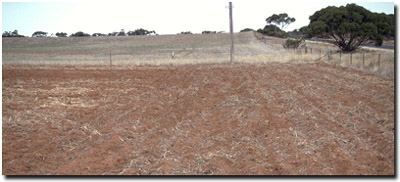 Site MP9 Landscape |
Soil Profile Morphology:
Surface Soil
| A1 | 0-10 cm | Dark reddish brown (5YR3/3); loamy sand; hardsetting surface condition; weakly structured; weak consistence dry; slightly calcareous; pH 7.9; sharp and smooth change to: | 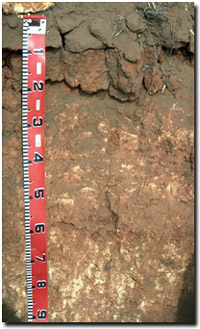 Site MP9 Profile |
| Subsoil | |||
| B21 | 10-25 cm | Dark red (2.5YR4/8); medium heavy clay; strong very coarse prismatic, parting to strong coarse blocky structure; strong consistence dry; moderately calcareous; pH 8.4; sharp change to: | |
| B22k | 25-60 cm | Dark red (2.5YR4/8); heavy clay; moderate coarse blocky structure; strong consistence dry; fine-earth carbonates and calcareous nodules common (10-20%); highly calcareous; pH 9.5; diffuse change to: | |
| B23k | 60-100 cm | Yellowish red (5YR5/8); medium clay; moderate blocky structure; strong consistence dry; contains many (20-50%) fine-earth carbonates; very highly calcareous; pH 9.8; diffuse change to: | |
| B31 | 100-160 cm | Yellowish red (5YR5/8) with reddish yellow (7.5YR6/8) mottles; sandy clay loam; massive; strong-very strong consistence dry; slightly calcareous; pH 9.9; diffuse change to: | |
| B32 | 160+ cm | Strong brown (7.5YR5/8); sandy clay loam; very strong consistence dry; pH 7.6. | |
Key Profile Features:
- Strong texture contrast between surface (A) horizons (9% clay) and the upper subsoil (B21) horizon (47% clay).
- Hardsetting surface soil with high sand content (88%).
- Large amounts of carbonates (lime) in the subsoil.
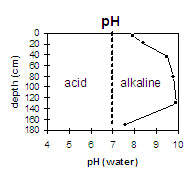 | 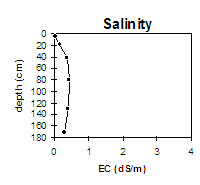 |
The surface is slightly alkaline. The subsoil is moderately alkaline, becoming extremely alkaline with depth. | The salinity rating is low throughout most of the soil profile becoming low-moderate at depth. |
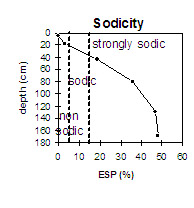 | 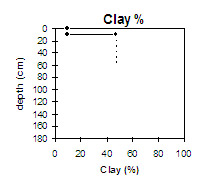 |
The surface soil is non-sodic. The deeper subsoil becomes strongly sodic at 40 cm. | The clay content increases sharply at 10 cm (the interface between the surface and the subsoil). |
Whole Profile
- In general, management strategies for all soils should aim to: increase organic matter levels in the surface soil, minimise the degradation of soil aggregates and porosity, promote the development of stable biopores, break up any hardpans, and improve the calcium status of the ion exchange complex. Particularly when sodium plays a significant part i.e. the soil is sodic. Less frequent tillage, using less aggressive implements, and working the soil at optimum moisture conditions can all assist in maintaining soil aggregation and porosity, as well as reducing the breakdown of organic matter. Farming practices on cropping soils such as residue retention, minimum tillage and pasture rotations could be utilised to build up organic matter, reduce erosion risk and increase the soils low inherent fertility.
- The low wilting point (3.3%) of the surface soil indicates that plants will be able to utilise light rains during dry periods. However, due to the surface soils low water storage capacity, plants will suffer moisture stress unless further rains occur. However, the shallow depth of the surface does mean that roots can access moisture if stored in the clayey subsoil.
- The strongly alkaline subsoil suggests that some nutrients (e.g. manganese, zinc, iron, copper) may be poorly available to plants. Boron toxicity can also occur in strongly alkaline soils.
- The coarsely structured subsoil below 40 cm depth becomes strongly sodic and dispersive indicating that root and water movement will be restricted into the subsoil. A suitable management option as the surface soil is shallow, would be to rip while incorporating gypsum. A test strip in the paddock could be used to assess its effectiveness. Deep ripping into the subsoil would assist in breaking up the physical structural problems and the application of gypsum would help to neutralise the chemical (i.e. sodic) problems. This expensive option would firstly depend on expected crop yield and also on adequate rainfall. Rain drop action washes the gypsum down the deep rips into the subsoil. Gypsum can also be added to the surface without deep ripping, but it would require more time to wash the gypsum into the subsoil and less of it would reach an effective depth.
- Waterlogging may occur after heavy rains as water builds up on the less permeable sodic subsoil.


